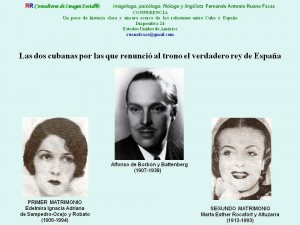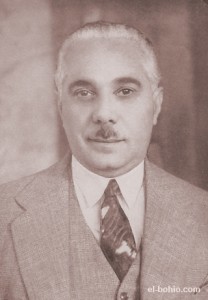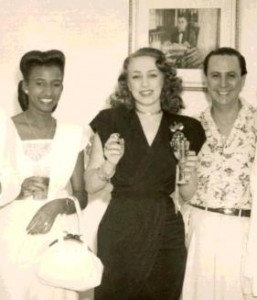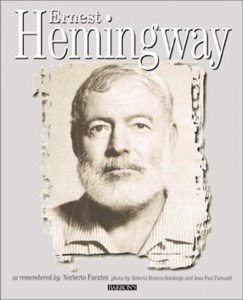DISTANT LOVES..
Did you know that was a Cuban the woman who inspired Saint-John Perse, Nobel Prize for Literature in 1960 – his famous poem “To the foreigner”?
That the great love of Ernest Hemingway in Havana was a mulatta called Leopoldina, and the writer in a novel immortalized the name of Liliana, the Honest?
Which one of the last lovers of Dominican dictator Rafael Leonidas Trujillo was a Cuban rumbera?
That was the Cuban boxer Kid Chocolate who loved actresses like Pola Negri and Misttinguette?
That Jose Raul Capablanca married an authentic Russian princess?
That Alfonso de Borbon, the eldest son of Alfonso XIII and uncle of King Juan Carlos, waived his right to occupy the throne of Spain to marry the Cuban Edelmira Sampedro?
That Miguelito Valdes had a romance with Patricia Hill, the so-called queen of the mafia, who was obsessed with the gold tooth of the singer?
That crime boss Meyer Lansky had a Cuban women for years and took her with him when he left Cuba in 1959 definitively?
That Ava Gardner, “the world’s most beautiful animal,” as her friend Hemingway called her, used to have authentic sexual marathons and white lovers but had more or less fixed, but always managed to sneak in a black fellow to her suite at the Hotel Nacional?
That the twins of Tongolele had the Cuban “brand”?
That the playwright Gerardo Leon Fullera took an afternoon to his bed to Marguerite Duras, author of “Hiroshima, my love”?
That the dictator Fulgencio Batista was in love with Rosita Fornes, the most desirable woman of Cuba?
IN CUBA there are doctors and researchers whose names go around the world. And writers, actors, athletes, composers, performers, filmmakers … In the famous relationship, for one reason or another, are always outside lovers. And lovers and lovers and great philanderers and women who loved or love left here there are lots worthy of inclusion in the gallery selected. Let’s run some of these stories …
ROYALTY.
It was love at first sight of Alfonso de Borbón, Prince of Asturias, and Edelmira Sampedro (pictured). They met one night at a cinema in the Swiss city of Lausanne and fell in love.
Everything was against the young couple from the start. The Spanish royal family did not accept the engagement, and Edelmira soon had to suffer the pressures of the envoys of Alfonso XIII, in exile in Paris, depriving the child of his five cars, significantly reduced their allowance and forced, ultimately, waive his right to succession. No member of the royal family attended the wedding in Lausanne on June 21, 1933, and invitations to the Count of Covadonga and extended to friends and acquaintances were returned “with feeling”.
Edelmira inordinate jealousy on the one hand, and hemophilia that afflicted Alfonso, on the other, would make it very difficult to live together. The couple breaks relationships over and over again, but always reconciled until 1937 when she accuses him of having another woman. It’s the end. In New York, Alfonso asked the annulment of marriage, and Edelmira in Havana, divorce.
The charge was Edelmira, this time, a real basis. Alfonso was secretly seeing another Cuban, Martha model Rocafort. They married in Havana in June 1937. Did Martha to the marriage driven by love or interest?
His immediate family confessed to this reporter that, while not ruling out the possibility of physical attraction, he leaned more to the latter than the former. And in a more or less similar was Camprubí Zenobia, the wife of Juan Ramon Jimenez, who continued in Havana the vicissitudes of the relationship. “I wish to be happy, Zenobia wrote in his diary, but it seems a marriage of convenience”.
Love or interest, this relationship did not last long. In September, only three months after the wedding, Martha filed for divorce. He refused to support Alfonso alcoholic crises that triggered the worst of his character and brought it to raw verbal and physical violence.
DICTATORS.
Although it is said that in his early youth, spent some time in the eastern city of Santiago de Cuba, the Generalissimo Leonidas Trujillo never really managed to ensure its expensive desire to be invited to visit the island officially. He was obsessed with all things Cuban: in furniture he was a client of La Moda, La Habana, which tailors he dressed, in Cuba and Cuban doctors who were treating him. Great dancer, boasted of Don Juan and liked his romances and love affairs were in the public domain because, in his opinion, confirmed his virility.
Trujillo also had a Cuban lover, the rumba dancer Silda. The author of this page saw a picture of her in the magazine Havana Show. Her skin was tan and a spectacular figure … Despite the praise that was lavished on this publication, she never raised its head in the nightlife capital: competition was too great. In Santo Domingo, however, achieved notoriety, if not in art itself by its relationship with the dictator, who once, perhaps to get rid of her, sent her to Spain in order to film a movie. And in Madrid surprised the execution of the satrap, on May 31, 1961. But Silda was not abandoned to their fate. An Arab sheikh, oil millionaire, got charged of her.
And what about Batista and Rosita Fornes?
The starlet’s own account in his memoirs. The Cuban dictator harassed her for a long time and when she made public her relationship with actor Armando Bianchi, persecution was extended to the two. The siege went from fines for minor traffic violations and long detentions in police stations to pressure from Secret Service agents and advice from people outside the business apparently urging the actress and singer “good behavior”. The harassment escalated when Rosa, in 1957, settled in Spain for work. The Cuban government then forbade her to take out her little daughter of the country.
“Batista hurt me a lot,” she says in her memories.
THE DEVIL IN HER BODY
“Islands in the stream”, Hemingway draws this description of Liliana, Honest: “She had a beautiful smile, beautiful dark eyes and black hair splendid (…) had a smooth complexion, a light olive ivory, ivory if such existed, with a slight pink hue …”
Honest Lil was inspired by a real person, a prostitute who made life at the bar and restaurant Floridita, Havana. She called herself Leopoldina, that might not be her real name, and the great American writer had with her a secret love that spread over many years.
Anthony Meilan, bartender at that establishment, who knew a lot and was a silent witness of that romance, still remembered in 1992. Then told this reporter: She was a beautiful mulatto woman, elegant, with its dazzling smile, her long legs, hips emphatic, brief breasts and that face on that crowded all the playfulness and grace of the Cuban.
He added:
That was herself a “female”! She had the devil in her body …
Leopoldina died of cancer in 1951. Hemingway covered the cost of burial. And it was the only man who accompanied her to the grave. That day at the Floridita, drank more than usual.
CiroBianchiRoss/Anecdotes/InternetPhotos/TheCubanHistory.com
The Cuban History, Hollywood.
Arnoldo Varona, Editor.
AMORES LEJANOS
¿Sabía usted que era cubana la mujer que inspiró a Saint-John Perse –Premio Nobel de Literatura en 1960- su célebre poema “A la extranjera”?
¿Que el gran amor de Ernest Hemingway en La Habana fue una mulata llamada Leopoldina, y que el escritor la inmortalizó en una novela con el nombre de Liliana, la Honesta?
¿Que una de las últimas amantes del dictador dominicano Rafael Leónidas Trujillo fue una rumbera cubana?
¿Qué el boxeador Kid Chocolate tuvo amores con actrices como Pola Negri y a Misttinguette?
¿Que José Raúl Capablanca se casó con una princesa rusa auténtica?
Que Alfonso de Borbón, el primogénito de Alfonso XIII y tío del rey Juan Carlos, renunció a su derecho a ocupar el trono de España para casarse con la cubana Edelmira Sampedro?
¿Que Miguelito Valdés sostuvo una relación con Patricia Hill, la llamada reina de la mafia, que vivía obsesionada con el diente de oro que lucía el cantante?
¿Que el jefe mafioso Meyer Lansky tuvo mujer cubana durante años y que la llevó consigo cuando salió definitivamente de Cuba en 1959? ¿Que Ava Gardner, “el animal más bello del mundo”, como le llamaba su amigo Hemingway, se entregaba aquí a auténticos maratones sexuales y que aunque tenía amantes blancos más o menos fijos, se las arreglaba siempre para colar algún que otro negro en su suite del Hotel Nacional?
¿Que era cubana la “marca de fábrica” de los mellizos de Tongolele?
¿Que el teatrista Gerardo Fullera León se llevó una tarde a la cama a Margarita Duras, la autora de Hiroshima, mi amor?
¿Que el dictador Fulgencio Batista vivía enamorado de Rosita Fornés, la mujer más deseada de Cuba?
EN CUBA hay médicos e investigadores cuyos nombres dan la vuelta al mundo. Y escritores, actores, deportistas, compositores, intérpretes, realizadores cinematográficos… En esa relación de famosos, por una razón u otra, quedan siempre fuera los amantes. Y amantes y grandes amadores y donjuanes y mujeres que amaron o se dejaron amar los hay aquí por montones dignos de figurar en la galería más selecta. Dejemos correr algo de estas historias…
DE LA REALEZA
Fue un amor a primera vista el de Alfonso de Borbón, Príncipe de Asturias, y Edelmira Sampedro (en la foto). Se vieron una noche en un cinematógrafo de la ciudad suiza de Lausana y se enamoraron.
Todo lo tuvo en contra la joven pareja desde el comienzo. La familia real española no aceptó el noviazgo, y Edelmira debió sufrir bien pronto las presiones de los enviados de Alfonso XIII, ya exiliado en París, que privó al hijo de sus cinco automóviles, redujo sensiblemente su mesada y lo obligó, en definitiva, a renunciar a su derecho a la sucesión. Ningún miembro de la Casa Real asistió a la boda, en Lausana, el 21 de junio de 1933, y las invitaciones que el ya Conde de Covadonga cursó a amigos y conocidos, le fueron devueltas “con sentimiento”.
Los celos desmedidos de Edelmira, por un lado, y la hemofilia que aquejaba a Alfonso, por otro, harían muy difícil la vida en común. Rompe la pareja sus relaciones una y otra vez, pero se reconcilia siempre hasta que en 1937 ella lo acusa de tener otra mujer. Es el fin. En Nueva York, Alfonso pedirá la anulación el matrimonio, y Edelmira, en La Habana, el divorcio.
La acusación de Edelmira tenía, esa vez, una base real. Alfonso estaba viéndose en secreto con otra cubana, la modelo Martha Rocafort. Se casarían en La Habana, en junio de 1937. ¿Llegó Martha a ese matrimonio impulsada por el amor o por el interés?
Un familiar cercano suyo confesó a este periodista que, aunque no descartaba la posibilidad de atracción física, se inclinaba más por lo segundo que por lo primero. Y de una opinión más o menos similar fue Zenobia Camprubí, la esposa de Juan Ramón Jiménez, que siguió en La Habana las peripecias de la relación. “Ojalá sean felices, escribió Zenobia en su diario, pero parece un matrimonio de conveniencia”.
Amor o interés, esta relación duró muy poco. En septiembre, tres meses escasos después de la boda, Martha solicitó el divorcio. Se negó a soportar las crisis alcohólicas de Alfonso que desencadenaban lo peor de su carácter y lo llevaban a crudas agresiones verbales y a la violencia física.
LOS DICTADORES
Aunque se dice que, en su temprana juventud, pasó una temporada en la ciudad oriental de Santiago de Cuba, el generalísimo Trujillo jamás logró que se hiciera realidad su caro anhelo de que lo invitaran a visitar la Isla de manera oficial. Vivía obsesionado con todo lo cubano: era cliente de la mueblería la Moda, de La Habana; se vestía con sastres cubanos y eran cubanos los médicos que lo atendían. Gran bailador, presumía de Don Juan y gustaba que sus romances y aventuras amorosas fueran de dominio público porque, a su juicio, confirmaban su virilidad.
Trujillo tuvo también una amante cubana, la rumbera Silda. El autor de esta página vio una foto suya en la revista habanera Show. Tenía la piel color canela y una figura espectacular… Pese a los elogios que en esa publicación se le prodigan, nunca levantó cabeza en la vida nocturna capitalina: la competencia era mucha. En Santo Domingo, sin embargo, logró notoriedad, si no por su arte, sí por su relación con el dictador, que un día, tal vez para quitársela de encima, la envió a España a fin de que filmara una película. Y en Madrid la sorprendió el ajusticiamiento del sátrapa, el 31 de mayo de 1961. Pero Silda no quedó abandonada a su suerte. Un jeque árabe, petrolero y millonario, cargó con ella.
¿Y lo de Batista y Rosita? Lo cuenta la propia vedette en sus memorias. El dictador cubano la acosó durante largo tiempo y cuando se hizo pública su relación con el actor Armando Bianchi, la persecución se extendió a los dos. El asedio iba desde multas por insignificantes infracciones de tránsito y largas retenciones en estaciones de policía hasta presiones por parte de agentes del servicio secreto y consejos de personas aparentemente ajenas al asunto que instaban a la actriz y cantante “a portarse bien”. El hostigamiento subió de tono cuando Rosa, en 1957, se estableció en España por motivos de trabajo. El gobierno cubano le prohibió entonces que sacara a su pequeña hija del país.
“Batista me hizo daño con eso, mucho daño”, dice ella en sus recuerdos.
EL DIABLO EN EL CUERPO
En “Islas en la corriente”, Hemingway traza esta descripción de Liliana, la Honesta: “Tenía una hermosa sonrisa, unos ojos oscuros maravillosos y espléndido pelo negro (…) Tenía un cutis terso, como un marfil color olivo, si tal marfil existiera, con un ligero matiz rosado…”
Liliana la Honesta se inspira en un personaje real, una prostituta que hacía la vida en el bar-restaurante Floridita, de La Habana. Se hacía llamar Leopoldina, -tal vez no fuera ese su nombre verdadero- y el gran escritor norteamericano mantuvo con ella un amor clandestino que se extendió a lo largo de muchos años.
Antonio Meilán, barman de ese establecimiento, que la conoció mucho y fue testigo mudo de aquel romance, la recordaba todavía en 1992. Contó entonces a este periodista:
-Una mulata fina, elegante, bellísima con su sonrisa deslumbradora, sus piernas larguísimas, las caderas rotundas, los pechos breves y aquel rostro en el que se agolpaban toda la picardía y la gracia de la cubana.
Añadió: -¡Eso sí era una hembra! Tenía el diablo en el cuerpo…
Leopoldina murió de cáncer, en 1951. Hemingway corrió con los gastos del sepelio. Y fue el único hombre que la acompañó hasta la tumba. Ese día, en el Floridita, bebió más de lo habitual.
CiroBianchiRoss/Anecdotas/InternetPhotos/THeCubanHistory.com
The Cuban History, Hollywood.
Arnoldo Varona, Editor.



 Distant Loves.. + Amores Lejanos..
Distant Loves.. + Amores Lejanos..



